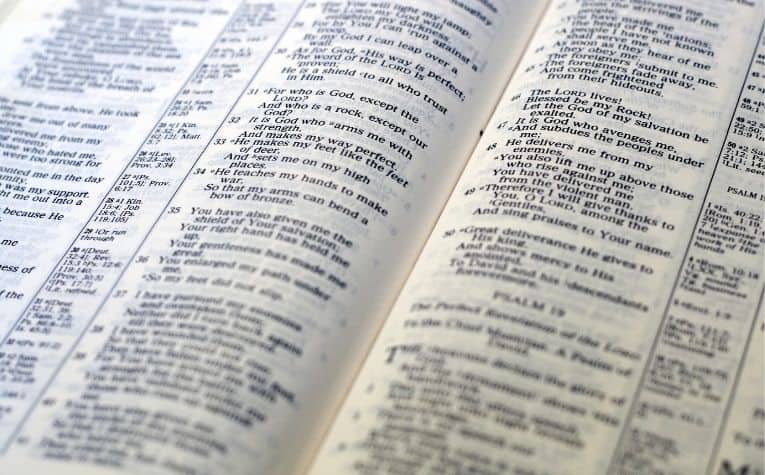The Scofield Study Bible and the Ryrie Study Bible are two of the last century’s most popular Christian reference resources. There are similarities between the Study Bibles because both men were devout, dispensational pretribulation premillennialists, which their study notes reflect. Yet they have differences as well.
The Scofield Study Bible and the Ryrie Study Bible are two classic resources that teach dispensational premillennial eschatology. Scofield’s original study notes also teach the Gap Theory of creation and utilize Bishop James Ussher’s timeline of history, which Ryrie’s notes don’t.
What makes the Scofield and Ryrie Study Bibles so special? Why do people like them so much? What exactly is dispensational premillennialism? Keep reading to learn more.
Also, see the Study Bible Comparison Chart to compare dozens of examples on one page.

Scofield and Ryrie: Comparison
The publication of the Scofield Study Bible was a seminal event because it resurrected a centuries-old way to teach the Bible (i.e., including explanatory notes and commentary) and the proliferation of dispensational premillennial eschatology.
Scofield’s Study Bible followed in the tradition of the 16th-century Geneva Study Bible, which contained notes to help explain Scripture. Today, hundreds of Study Bibles are on the market, thanks in part to the success of Scofield’s work, which influenced later generations.
Scofield’s Study Bible became a tremendously popular resource in his day and was used in churches and Bible schools, and he went overseas with missionaries. As the Study Bible grew in popularity, so did dispensational premillennialism (see a summary below).
Scofield’s Study Bible influenced many leading pastors and theologians and impacted millions of Christians who read it regularly, like Charles Ryrie.
To understand the difference between the Scofield and Ryrie Study Bibles, it’s essential to understand the differences between the men’s lives and ministries. There are more similarities than differences between the books. The comparison table below offers key information about each man.
| C.I. Scofield | Charles Ryrie |
|---|---|
| Lived: 1843-1921 | Lived: 1925-2016 |
| Education: unknown; later in life, he signed his name “DD” for Doctor of Divinity | Education: Master’s and Doctorate of Theology, Dallas Theological Seminary |
| Ministry: Pastored in Congregational, Reformed churches | Ministry: Taught at Dallas Theological Seminary and other schools |
| Cairn University: founder | Cairn University: president of Cairn from 1958-1962 |
| Dwight Moody: served with Moody | Dwight Moody: Study Bible published by Moody Press |
| Study Bible published: 1909 | Study Bible published: 1976 |
| Theology: theologically conservative | Theology: theologically conservative |
| Eschatology: dispensational premillennialism | Eschatology: dispensational premillennialism |
Also, see Study Bible vs. Reference Bible: What’s the Difference? for more.
Scofield and Ryrie: Key Differences
The Gap Theory: Scofield’s Study Bible teaches the Gap Theory of creation in its notes on Genesis 1. The Gap Theory suggests there is a “gap” of geologic time between Genesis 1:2 and Genesis 1:3.
The Gap Theory often contrasts with other views on natural order, including Young Earth creationism, Old Earth creationism, and various evolutionary theories. Ryrie’s Study Bible doesn’t advocate for the Gap Theory.
Scofield’s note on Genesis 1:2 reflects The Gap Theory: “clearly indicate that the earth had undergone a cataclysmic change as the result of divine judgment. The face of the earth bears everywhere the marks of such a catastrophe. There are not wanting imitations which connect it with a previous testing and fall of angels.”
Ussher’s timeline of history: James Ussher (1581-1656), an Irish Anglican bishop, is best known for teaching that God created the Earth on October 23, 4004 B.C. Some Christians agreed with Ussher’s teaching, including Scofield.
Old Scofield vs. New Scofield
The 1967 “New Scofield Study Bible” removed the teaching, but later editions placed it back in the study notes. Ryrie’s Study Bible doesn’t include Ussher’s timeline.
King James Version: Scofield’s original (or “Old”) Study Bible, published in 1909, used the King James version of the Bible. So, too, did the revised edition of 1917.
Scofield died in 1921. An eight-person committee revised the Study Bible in 1967. The “New” edition, also called “Scofield III,” comes in a variety of English translations. Ryrie’s Study Bible also comes in various English translations, like the KJV, NJKV, NIV, ESV, and NASB.
Also, see Is a Study Bible Good to Use? for more.
What is dispensational premillennialism?
The word “premillennialism” refers to the belief that Jesus will return to Earth before the 1,000 years described in Revelation 20:1-6.
Premillennialism is often contrasted with amillennialism, which means “no millennium,” yet it’s the belief that the 1,000-year period described in Revelation 20 is the time between Christ’s first and second coming. Amillennialism, therefore, interprets 1,000 figuratively.
Premillennialism is also contrasted with postmillennialism, which is the belief that Jesus’ Second Coming will occur at the end of the 1,000-year reign of Christ. Postmillennialists interpret the 1,000 literally. However, they hold to a different end-time chronology than premillennialism.
What is dispensationalism?
A dispensation refers to an era of times. Dispensationalism interprets Scripture in a manner that divides history into different eras. Scofield defines the term this way:
“A dispensation is a period of time during which man is tested in respect of obedience to some specific revelation of the will of God. Seven such dispensations are distinguished in Scripture.” (Scofield Study Bible, pg. 5)
Not all dispensationalists count the eras the same way. However, Scofield’s classic view sees seven in total: Innocence, Conscience, Government, Promise, Law, Grace, and Kingdom/Millennium.
Also, see Best Revelation commentaries for more.
Premillennialism: The order of major end times events
The rapture: The rapture is the first and next event on God’s end times schedule. The rapture refers to the sudden, supernatural removal of Christians from the Earth. Premillennialism teaches that the rapture could happen at any moment — even today.
The tribulation: The seven-year tribulation period follows the rapture (though it isn’t triggered by it). Dispensational premillennialists believe it’s described in Revelation 6-19.
The Holy Spirit is removed from the Earth during the tribulation, and the Antichrist and False Prophet wreak havoc upon people. The period ends with the Battle of Armageddon.
The Second Coming: Christ’s return to Earth follows Armageddon and the tribulation period. He will judge the Earth and establish his 1,000-year millennial kingdom described in Revelation 20:1-6. All eschatological views hold to the return of Christ, but there isn’t agreement about when it will occur.
The Millennium: Dispensational premillennialist believe the 1,000-year period is literal and in the future. Other views believe it is occurring in the present and that the number is figurative.
The eternal state: Also called the Final State, it’s the last period of time — which lasts for all eternity — in which people are either in heaven or hell.
Also, see What is a Devotional Bible? to learn more.
Also see:
Reference Bibles vs. Study Bibles
References:
[1] Source
[2] Source
[3] Source
[4] Source
Related Questions
Whole Bible commentaries will help you understand every passage of Scripture better. If Bible commentaries on single books are like studying individual trees, whole-Bible commentaries will help you...
With so many Bible commentary series available today, many people want to know which ones are best. There is a wide variety of commentary series today because readers have various purposes for using...
